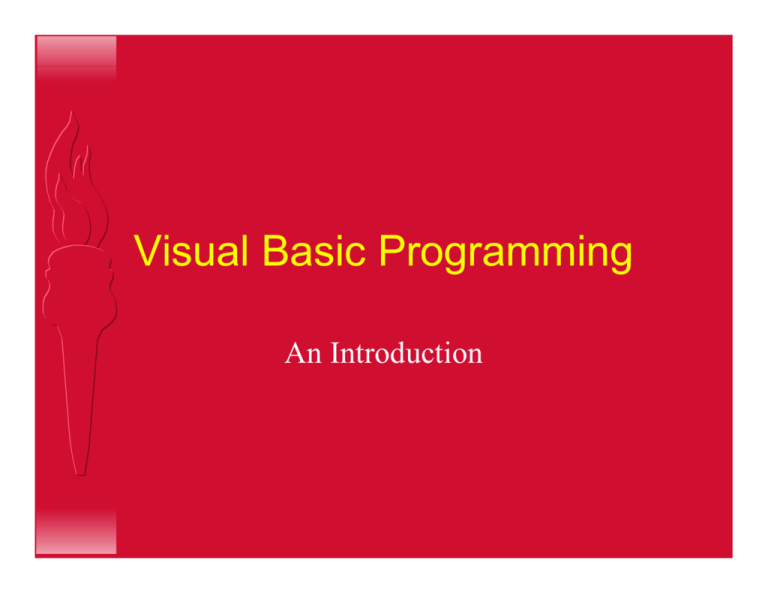Visual Basic Programming
advertisement

Visual Basic Programming An Introduction Why Visual Basic? Programming for the Windows User Interface is extremely complicated. H Other Graphical User Interfaces (GUI) are no better. H Visual Basic provides a convenient method for building user interfaces. H Visual Basic can interface with code written in C, for efficiency. H What Visual Basic is not Visual Basic is not, a powerful programming language that enables you to do anything you want. H Visual Basic is not, elegant or fast. H Visual Basic is not, a replacement for C. H Visual Basic is not, anything like any other programming language you have ever used. H When You Program in VB: You draw pictures of your user interface. H You draw buttons, text boxes, and other user-interface items. H You add little snippets of code to handle the user interaction. H You add initialization code, usually as the last step. H If you like, you can code more complex functions. (But many do not.) H The Visual Basic Interface Draw Your Program Here! Drawing The Program Select A Control From Here (Click on the appropriate button) Then Draw the control on the form Types of Controls Static Text Group Box Check Box Scroll Bar Drop-Down List Timer Folder Hierarchy Circles and Stuff Pictures Pictures Editable Text Button Radio Button List Scroll Bar Drive List File List Lines Data Base Access And the List Goes On and On ... A Simple Program Double-Click to Add Code Single-Click to Select and Change Properties Using controls: Static Text Editable Text Buttons The Properties Window List of Properties For Currently Selected Control Click on Property, and Type In New Value, or Select New Value From Menu. Adding Code Control Name External Event Name You must Write The Body Yourself What to Do When It Happens More Complex Controls H Complex Controls Have: – Action Properties to Execute Commands – Active Properties that Cause Actions When Values Are Assigned to Them – Many Types of Events for Program Interaction H Examples: – Spreadsheets – Word Processors – Web Browsers Using C Code Write a DLL in C H Use the _export Property on Appropriate Functions H Write Visual Basic Definitions for each Function H Add VB Definitions to The (general) section of the VB Program H Use Functions as if they were VB functions H C Definition vs. VB Definition C: long FAR PASCAL _export HexToLong (char *Hex) VB: Declare Function HexToLong Lib “FIRSTONE.DLL” (ByVal InString As String) As Long Function Name Must Be The Same in Both Declarations. The Lib keyword Must Give The Name of the Library. Argument Name in VB is arbitrary. A (Very Annoying) Problem It is sometimes difficult for VB to FIND the .DLL file. H If this occurs, copy the .DLL file to the WINDOWS directory. H Remember to Delete the file when you are done. H Alternative Methods Some Versions of VB do not allow DLL function definitions in the (general) section of a form. H To Get Around this Problem, Create a new Module (File Menu) H Add the declarations to the (general) section of the module H You can add your own VB functions to the (general) section of a form or a module. H Syntax Considerations All Functions are Global in VB H Variables are declared using the syntax: H – Dim <Name> As <Type> – Every variable must have a type – Dim A,B,C As <Type> will work, but gives weird results H Most Common Types: Integer, String, Long More VB Syntax H Use Integers for Booleans – As in C, 0 = False, everything else = True – Symbolic constants True and False may be used – True = -1, False = 0 Assignments are the same as in C H The Val function converts strings to integers H The Format$ function converts integers to strings H VB Statements Assignments are the Same as in C H Case is not significant H – Case will be adjusted for you on keywords – For Variable Names, Case is ignored H The Usual Operators can be used – AND is the same as both & and && depending on context – OR = | and || – NOT = ! VB IF Statements If <condition> Then <List of Statements> Else <List of Statements> EndIf If <condition> Then <List of Statements> EndIf Comparators: =,<, >, <=, >=, < > (not equal) Connectives: And, Or, Not DON’T FORGET THE ENDIF! VB While Statements While <condition> do <List of Statements> Wend The VB Manual Recommends a different structure. Use the alternative if you wish. VB For Statements For <Variable> = <start> to <finish> <List of Statements> Next <Variable> For <Variable> = <start> to <finish> Step <increment> <List of Statements> Next <Variable> Example: For I = 1 to 10 do A[I] = A[I] + 1 Next I VB Arrays Indices Always Start With Zero H Dim A[10] As Integer Declares 11 elements, indexed from 0 through 10. H Multi-Dimensional Arrays are Permitted. H Arrays can be resized at run time (See VB Help File for ReDim) H VB Strings Variable Length H Compare using standard comparators H Maximum length is about 64Kb H Minimum length is zero H Allocated from VB “String Space”, so may run out of space even on systems with much memory. H And in Conclusion ... Go Have Fun! Visual Basic Programming An Introduction Why Visual Basic? Programming for the Windows User Interface is extremely complicated. H Other Graphical User Interfaces (GUI) are no better. H Visual Basic provides a convenient method for building user interfaces. H Visual Basic can interface with code written in C, for efficiency. H What Visual Basic is not Visual Basic is not, a powerful programming language that enables you to do anything you want. H Visual Basic is not, elegant or fast. H Visual Basic is not, a replacement for C. H Visual Basic is not, anything like any other programming language you have ever used. H When You Program in VB: You draw pictures of your user interface. H You draw buttons, text boxes, and other user-interface items. H You add little snippets of code to handle the user interaction. H You add initialization code, usually as the last step. H If you like, you can code more complex functions. (But many do not.) H The Visual Basic Interface Draw Your Program Here! Drawing The Program Select A Control From Here (Click on the appropriate button) Then Draw the control on the form Types of Controls Static Text Group Box Check Box Scroll Bar Drop-Down List Timer Folder Hierarchy Circles and Stuff Pictures Pictures Editable Text Button Radio Button List Scroll Bar Drive List File List Lines Data Base Access And the List Goes On and On ... A Simple Program Double-Click to Add Code Single-Click to Select and Change Properties Using controls: Static Text Editable Text Buttons The Properties Window List of Properties For Currently Selected Control Click on Property, and Type In New Value, or Select New Value From Menu. Adding Code Control Name External Event Name You must Write The Body Yourself What to Do When It Happens More Complex Controls H Complex Controls Have: – Action Properties to Execute Commands – Active Properties that Cause Actions When Values Are Assigned to Them – Many Types of Events for Program Interaction H Examples: – Spreadsheets – Word Processors – Web Browsers Using C Code Write a DLL in C H Use the _export Property on Appropriate Functions H Write Visual Basic Definitions for each Function H Add VB Definitions to The (general) section of the VB Program H Use Functions as if they were VB functions H C Definition vs. VB Definition C: long FAR PASCAL _export HexToLong (char *Hex) VB: Declare Function HexToLong Lib “FIRSTONE.DLL” (ByVal InString As String) As Long Function Name Must Be The Same in Both Declarations. The Lib keyword Must Give The Name of the Library. Argument Name in VB is arbitrary. A (Very Annoying) Problem It is sometimes difficult for VB to FIND the .DLL file. H If this occurs, copy the .DLL file to the WINDOWS directory. H Remember to Delete the file when you are done. H Alternative Methods Some Versions of VB do not allow DLL function definitions in the (general) section of a form. H To Get Around this Problem, Create a new Module (File Menu) H Add the declarations to the (general) section of the module H You can add your own VB functions to the (general) section of a form or a module. H Syntax Considerations All Functions are Global in VB H Variables are declared using the syntax: H – Dim <Name> As <Type> – Every variable must have a type – Dim A,B,C As <Type> will work, but gives weird results H Most Common Types: Integer, String, Long More VB Syntax H Use Integers for Booleans – As in C, 0 = False, everything else = True – Symbolic constants True and False may be used – True = -1, False = 0 Assignments are the same as in C H The Val function converts strings to integers H The Format$ function converts integers to strings H VB Statements Assignments are the Same as in C H Case is not significant H – Case will be adjusted for you on keywords – For Variable Names, Case is ignored H The Usual Operators can be used – AND is the same as both & and && depending on context – OR = | and || – NOT = ! VB IF Statements If <condition> Then <List of Statements> Else <List of Statements> EndIf If <condition> Then <List of Statements> EndIf Comparators: =,<, >, <=, >=, < > (not equal) Connectives: And, Or, Not DON’T FORGET THE ENDIF! VB While Statements While <condition> do <List of Statements> Wend The VB Manual Recommends a different structure. Use the alternative if you wish. VB For Statements For <Variable> = <start> to <finish> <List of Statements> Next <Variable> For <Variable> = <start> to <finish> Step <increment> <List of Statements> Next <Variable> Example: For I = 1 to 10 do A[I] = A[I] + 1 Next I VB Arrays Indices Always Start With Zero H Dim A[10] As Integer Declares 11 elements, indexed from 0 through 10. H Multi-Dimensional Arrays are Permitted. H Arrays can be resized at run time (See VB Help File for ReDim) H VB Strings Variable Length H Compare using standard comparators H Maximum length is about 64Kb H Minimum length is zero H Allocated from VB “String Space”, so may run out of space even on systems with much memory. H And in Conclusion ... Go Have Fun!





